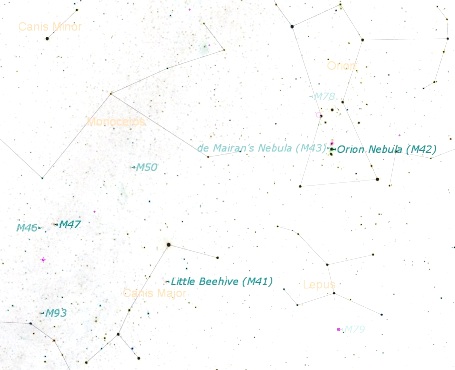|





| |
Fundamental Sky Skills
Prior to using a telescope...
Know which way is North
- This is actually harder than it sounds and changes all the time. A
link is provided here.
- We'll generally list the obvious naked-eye targets (Moon, Jupiter, Orion
Nebula)
- Right now (mid-January 2011) in the evening sky, the brightest thing in
the sky is Jupiter, in the southwest. Orion and the Orion Nebula are
in prime viewing position. Saturn rises late. See the various
Sky-At-a-Glance links for details.
Be able to read a Sky Map or Planisphere
Generally, Sky Maps have the cardinal directions (N, S, E, W) printed on
them. They are designed to be held overhead. Face a direction, hold
the map overhead with the directions lining up. Look for bright stars that
match the bright stars on the map. Once you've matched the brighter stars,
you should be able to identify the fainter stars and other objects.
For example, facing south, hold the star map overhead with the south side of
the map facing south.
Note that the planets and the moon are generally not printed on permanent
maps. Jupiter, Saturn, Venus and Mars are typically as bright or brighter
than the brightest stars and may confuse you. Weekly and monthly star
charts downloaded from the internet generally do show the location of the
planets
|
Planispheres contain the whole sky but are designed to block out the part of
the sky that you cannot see at a given time. You'll get a window with only
the stars and constellations you can see at that given time.
Find the date along the
circumference of the planisphere. Rotate the sliding part of the
planisphere so that the current time lines up with the current date. The
sky visible in the planisphere will now match the sky you see. You can
rotate the planiphere to see how the stars progress over the course of a night
or over the course of a year.
Due to the fact that they are trying to get the entire sky on in a
small space, they tend not to be very detailed and do not list faint
objects. You generally need more detailed star maps to find anything
other than the brightest objects.
They are excellent for learning constellations. |
 |
Learn some Constellations
| Constellations are a way to chop the huge night sky up into small, navigable
chunks. For example, if you can find Orion, you can find some of the cool
objects in Orion. Learning some constellations is a way to learn the sky.
The sky delineated into Constellations is like the USA delineated into
States: it's easier to find things. A planisphere is an excellent way to learn the constellations.
Once
you know what constellations are up. There are a number of sky
atlases and books that break down the deep sky objects by constellation.
Alternatively, they break the constellations down by month. But in
any case, once you know what constellations are up, the next step is to
know what is in them.
|
 |
Next: What's Up?
Be able to star-hop or manually find some of the easier targets (Pleiades,
Beehive or other star cluster). We should have detailed steps for this. |